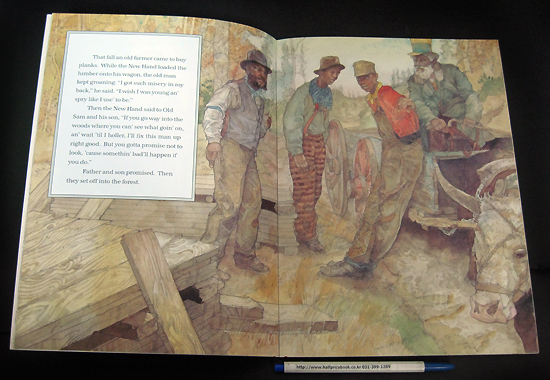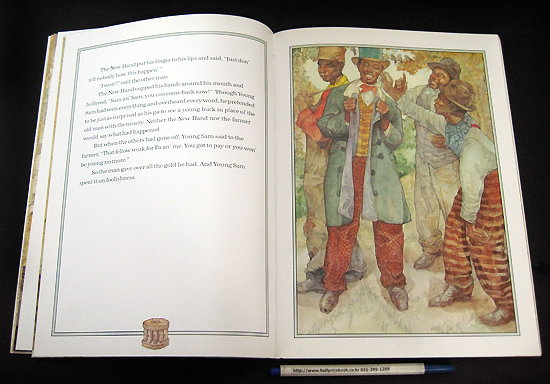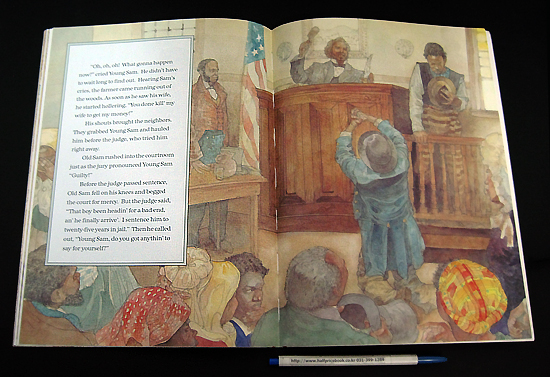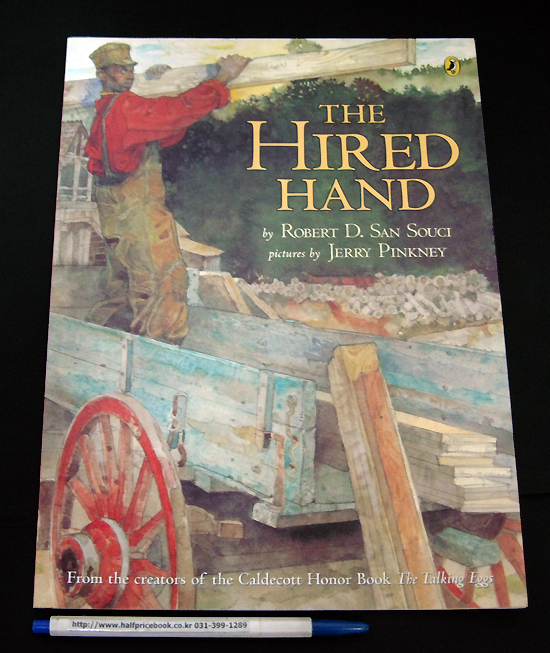|
|
|
|
 |
 이전 | 이전 |  목록 | 다음 목록 | 다음 |
|
확대 이미지 : 상세보기1

|
확대 이미지 : 상세보기2

|
확대 이미지 : 상세보기3

|
확대 이미지 : 상세보기4

|
[ 책 소개 ]
* New York Times Best Illustrated Children's Book
The Talking Eggs로 Caldecott상을 수상한 Robert D. San Souci(글)와 Jerry Pinkney(그림)가 힘을 합쳐 만든 명작 그림책입니다.
물레방아의 힘으로 나무를 자르는 조그만 목재소를 운영하는 Old Sam에게는 아들이 한 명 있었습니다. 아들은 게으를 뿐만 아니라, 아버지의 말도 잘 듣지 않았습니다. 아들이 목재소 일에 전혀 도움이 되지 않자, 아버지는 새로운 일꾼을 구하였지요. 새로운 일꾼이 오자, 아들은 더욱 더 일을 안하고, 새 일꾼을 가혹하게 부려 먹었습니다. 어느날 일꾼은 허리가 아픈 노인을 마법을 이용해서 고치고, 아들은 이 광경을 몰래 훔쳐 봅니다. 그리고 아버지가 멀리 출장을 간 사이에 일꾼을 내쫓아 버리고, 병을 고친 노인이 데려온 부인의 병을 자신이 고칠 수 있다고 큰 소리를 칩니다. 하지만 부인은 병이 낳기는 커녕, 오히려 죽음을 맞게 되고, 아들은 살인죄로 법정에 서게 됩니다. 이들은 뒤늦게 자신의 잘못을 깨닫게 되지만, 법원은 25년형을 선고하고, 그 때 나타난 일꾼은...
[ 서지 정보 ]
Edition: Paperback, 40 pages
ISBN-10: 0142404500
ISBN-13: 978-0142404508
책 크기: 29.2 cm x 21.6 cm
[ 영문 서평 ]
Book Description
Robert D. San Souci based this tale on an account by a black Virginian that was first written down in 1871, though it was told orally generations earlier. Jerry Pinkney chose to set the story in the late 1700's, in one of the Virginia towns where free blacks and whites lived, worked as craftsmen, and owned property long before the Civil War.
Publisher's Weekly
Seasoned collaborators San Souci and Pinkney (The Talking Eggs) weave themes of magic, rebirth and retribution into another splendid retelling of an African American folk tale. The story, told in homespun dialect, involves a stranger who turns up at a sawmill looking for work. Although the man is "as shabby as a worn-out shoe," Old Sam, the owner, is delighted to hire him. But Old Sam's shiftless, "no 'count" son soon spies out the hardworking New Hand's magical powers, and when his high-handed, "biggity" ways drive the stranger away, he attempts to duplicate the man's trick of rejuvenating people by transforming them into wood, sawing them apart, soaking them in water and anointing them with a drop of his own blood. Young Sam gets the incantations right ("Sawdust!/ Do what you must!/ Turn this skin an' bone to wood/ So my saw cut but don' draw blood"), but cheats on the final step, with disastrous results. In the end, the hired hand reappears at the remorseful Young Sam's murder trial and saves the day. Informed by the careful research for which this dynamite duo is so well known and graced with Pinkney's charismatic watercolors, the tale has a particularly interesting setting: an antebellum Virginia community of free black craftsmen, upon which the artist elaborates in an afterword. Shivery and superbly crafted.
Children's Literature
Magic fills this tale of an African-American stranger who comes to a town of free blacks and seeks a position in the local sawmill. The owner is a good man, but his son is lazy and mean. He treats the New Hand badly and spies on him when he rejuvenates an old farmer. When the son tries to do the same for another couple and fails, it is up to the New Hand to rescue him. The mill owner's son learns his lessons about how to treat people and how to be a better son. The pencil and watercolor illustrations are beautiful. They accurately show the people, period clothing, and mysterious settings. While an original tale, it has the feel and look of a folk tale. - Marilyn Courtot
School Library Journal
The Hired Hand explores the danger associated with stealing someone's magic. It echoes this talented team's collaboration for The Talking Eggs (Dial, 1989) in its distinguished appearance, understated mood, straightforward retelling, and even pace. The story spins around a New Hand at a sawmill who returns youthfulness to an old man, and a miller's son who tries unsuccessfully to duplicate that feat for profit. San Souci makes a choice in favor of "softening the heavy use of dialect," found in the original tale. Pinkney adopts a corresponding tone in his illustrations, polishing any harshness away. Pencil sketches showing through his watercolors add character and interest, but never mar the finish. The result is a first-class treat for readers' eyes and ears. However, the prettiness has a price. The beauty (each illustration perfectly composed and delivered in a charming palette of subdued colors; each bit of dialogue tastefully framed; each character devastatingly handsome) keeps drawing readers' attention back to the surface, to the elegance of the presentation. Beneath that surface, down where the folktale's dynamic themes of filial disobedience, sin and redemption, and the search for immortality all converge, is where the real power lies. Libraries looking for African-American folktales should consider this title and bask in the splendor of its delivery. For fun, pair it with dePaola's Strega Nona (S&S, 1975), in which another magician wannabe misses the master's nuance.Liza Bliss, Worcester Public Library, MA
Booklist
Old Sam, the owner of a prospering sawmill, hires additional help because his own son is so lazy. The "New Hand" is conscientious and willing to work for free in order to learn the trade--a fact that Young Sam is quick to exploit. When an elderly customer arrives complaining of back pain, the New Hand sends the Sams away and performs a miracle, making the man young and healthy again. Later, Young Sam (who secretly observed the transformation) tries to repeat the trick on the customer's wife, with disastrous results. Just as Young Sam is being carted off to jail for murder, the New Hand reappears, and, satisfied that Sam has learned his lesson, resurrects the woman, enabling Sam to go free. San Souci and Pinkney's latest collaboration is based on an African American folktale first recorded in 1871 by a black Virginian. Pinkney's characteristic watercolor illustrations portray one of several small Virginia towns where free blacks lived, owned property, and worked in the late 1700s. He successfully blends historically realistic details with timeless folkloric magic, and he enhances San Souci's smooth retelling in the process. An obvious choice for primary story hours, this will also make a welcome addition to African American folklore and history units. Kay Weisman
Kirkus Reviews
An African-American folktale from Southern oral tradition, first recorded in the late 19th century. Down Virginia way, Young Sam, the lazy, no-account son of a sawmill owner, has his life turned upside-down when a hired hand shows up asking for work. Young Sam spies on New Hand, and discovers that the man has the power to rejuvenate an old farmer with sawdust, water, and a drop of blood accompanied by magical incantations. Young Sam exploits his knew knowledge and accidentally kills the woman he's trying to make young, landing himself in court. What begins as a gripping, well-told tale starts to sound like a morality play, as Young Sam repents his lazy ways. Born as it is of pure desperation, his conversion (for readers) strains credibility. But New Hand believes Young Sam and bails him out by presenting to the court the woman who was supposed to have been dead. Inspired by a small Virginia anti-slavery town for its setting and drawing from 18th-century costume with the influence of European fairy-tale art, Pinkney works his magic by blending both character and drama with the hushed tones of history.
|
| * 최근 이 작품을 구입하신 분들의 다른 선택 |
The Wreck of the Zephyr
뉴욕타임즈 최우수 그림책 수상작, 하드커버, 슈퍼바이 |
Rosa
Caldecott 수상작, 페이퍼백, 슈퍼바이 |
The Never Girls 3권 합본책
하드커버, Books 1-3 합본책, 슈퍼바이 |
1000 Piece Jigsaw Puzzle: New York
1천 피스 직소퍼즐, 슈퍼바이 |
|
| |
|
|< << [1] [2] [3] [4] [5] [6] [7] [8] [9] [10] >> >|
|
|
|